James H. White & Frederick Blechynden
Part III: More Westward Actualities
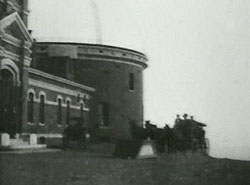 A view is given of the outside of the Lick Observatory, Mt. Hamilton, Cal. (1897), with a horse-drawn wagon providing the motion in front of the architecture.
A view is given of the outside of the Lick Observatory, Mt. Hamilton, Cal. (1897), with a horse-drawn wagon providing the motion in front of the architecture.
Saturdays were traditionally open for the general public, & tourists had access to the mountain top by a crazily winding road, the slopes being otherwise too steep for horse-drawn vehicles, as seen in the actuality.
This one's frankly one ofd the least interesting actualities, since nothing really happens & nothing is brought to the half-minute that one wouldn't get from a plain photograph or tourist post card.
Lick Observatory is today an extension of the University of California at Santa Cruz. Mount Hamilton is in the Diablo Range & overlooks San Jose. The observatory was built in 1876, with a new refracting telescope installed in 1888.
This was the world's largest refracting telescope until one larger was built in Illinois, the Yerkes Observatory. Licks Observatory was the first-ever mountain top observatory that was occupied twenty-four hours a day.
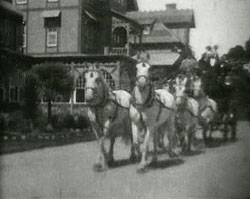 Located along the Southern Pacific Rail Road's "Sunset Line" in Monterey, Hotel del Monte (1897) was this quid pro quo film.
Located along the Southern Pacific Rail Road's "Sunset Line" in Monterey, Hotel del Monte (1897) was this quid pro quo film.
In trade for the inevitable advertisement value of being featured in Edision Manufacturing Company films, the rail road companies underwrote travel & lodging expenses, & the filmmakers focused their cameras on major tourist destinations reached by trains.
The view of the hotel from the street begins with a large carriage drawn by six white horses, the carriage loaded down with men waving at the cameraman with their hats. This is followed by three more smaller carriages.
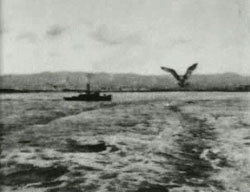 San Francisco can be seen in the distance, from the Oakland ferry, in the appealing wee film Feeding Sea Gulls (1898), from the "Southern Pacific Company Series" for the Sunset Route.
San Francisco can be seen in the distance, from the Oakland ferry, in the appealing wee film Feeding Sea Gulls (1898), from the "Southern Pacific Company Series" for the Sunset Route.
The ferries of Bay knitted San Francisco, Oakland, Alameda, & at various times other locations into an extensive community of cities & towns, & were signal to the development of the region.
Most of the runs were short enough that tourists could take a breezy ride with amazing views all along the way, & shoppers or laborers had daily access to a large region.
The gulls soon learned tourists would feed them. Sea gulls accumulate in the updraft over the wake of the speeding ferry, hoping for hand-outs. We see a tugboat some ways off pulling a scow.
Halfway through there's a veritable jump-cut as the camera was stopped & started, for a view over the water of a point of land in the bay.
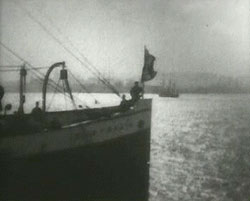 Leaving San Francisco in Troopships for the Philippines (1998) are the S. S. "Australia" & the S. S. "City of Sidney," taking troops to participate in the Spanish-American War. A third ship left at athe same time, the S. S. "City of Peking," but it did not make it into the nearly two-minute film.
Leaving San Francisco in Troopships for the Philippines (1998) are the S. S. "Australia" & the S. S. "City of Sidney," taking troops to participate in the Spanish-American War. A third ship left at athe same time, the S. S. "City of Peking," but it did not make it into the nearly two-minute film.
It's the "Australia" we see first. Soldiers are numerous behind the smokestack, to the stern, waving their farewells toward the docks.
As the "Australia's" stern flag passes out of view, there's a jump-cut to a flagpole with no flag on it, apparently on the dock though we can't see the base. Entering the picture is "The City of Sydney" with two smoking tugs behind her.
With another jump-cut we're shown a different angle of "The City of Sidney" exiting the harbor, the tubgoats most visible.
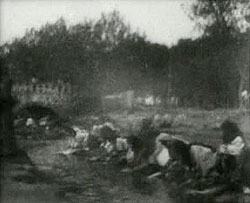 White & Blechynden's filmmaking in the west was underwritten in great part by the various railroad companies that took them first to California, then up & down the coast as far south as northern Mexico to as far north as Seattle.
White & Blechynden's filmmaking in the west was underwritten in great part by the various railroad companies that took them first to California, then up & down the coast as far south as northern Mexico to as far north as Seattle.
Wash Day in Mexico (1898) was filmed near Durango, & was part of what was advertised as the "Mexican International R. R. Series."
Mexican women are lined up along a stream, each with a flat stone on which they scrub their laundry. Such scenes were regarded as "quaint & picaresque" & would encourage tourists to take the train from California hoping to see just such moments.
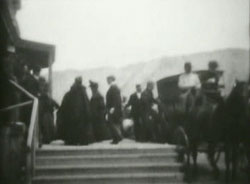 Another travel film captures the arrival of horse-drawn carriages at Yellowstone National Forest.
Another travel film captures the arrival of horse-drawn carriages at Yellowstone National Forest.
The Northern Pacific Rail Road managed Wyoming's Yellowstone Park in the 1890s, trains to & stagecoaches around the park. So the filmmakers were still doing quid pro quo.
It was Thomas Alva Edison's genius, however, to get others to pay for journeys that would've been made in any case, & national parks were very salable as film subjects.
Coaches at Mammoth Springs (1899) focuses on the staired piazza of the Mammoth Springs Hotel. And despite the copyright date of the Yellowstone films, they were really filmed in July 1897.
Two coaches & teams pull up alongside the piazza & passengers disembark. Considering the beauty of the area, the camera seems very poorly placed. We don't really see the hotel architecture & we don't see the natural surroundings.
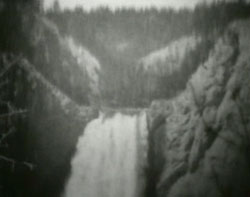 We're essentially treated to a view of the same sorts of carriages we'd see in any city street "actuality" of the era. We're essentially treated to a view of the same sorts of carriages we'd see in any city street "actuality" of the era.
Also from the "Northern Pacific Rail Road" series, Lower Falls, Grand Canyon, Yellowstone Park (1899) is a truly beautiful filmlette, showing the waterfall running strong & wide.
As with most tourist actuality films, it's an unchanging angle for the full half minute length. It does not show the height of the falls nor the canyon's depth, but it certainly captures the fall's grandeur.
The Yellowstone Grand Canyon is not the enormous thing the Grand Canyon in Arizona is, but no one will be making disdaining comparisons when the Lower Falls comes into view.
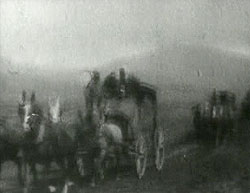 Hikers in this area of the park will find many amazing vantage-points for viewing, the view from Artist's Point being most notable. Lower Falls is probably in the top three most photographed sites in Yellowstone. Hikers in this area of the park will find many amazing vantage-points for viewing, the view from Artist's Point being most notable. Lower Falls is probably in the top three most photographed sites in Yellowstone.
Tourists Going Round Yellowstone Park (1899) shows one of the stage lines operated throughout the park by the rail road, such as made vast stretches of wilderness area accessible to tourists.
The popularity of the park is reflected by the fact that the four-horse coaches are heading out one after another after another.
It looks so much like wild west, except one always imagines the next coach won't be for a week or two, rather than immediately behind the present one.
copyright © by Paghat the Ratgirl
|
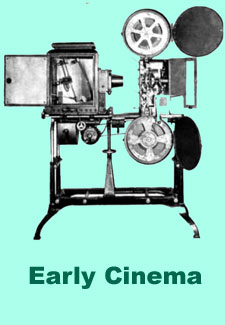


 San Francisco can be seen in the distance, from the Oakland ferry, in the appealing wee film Feeding Sea Gulls (1898), from the "Southern Pacific Company Series" for the Sunset Route.
San Francisco can be seen in the distance, from the Oakland ferry, in the appealing wee film Feeding Sea Gulls (1898), from the "Southern Pacific Company Series" for the Sunset Route.


 We're essentially treated to a view of the same sorts of carriages we'd see in any city street "actuality" of the era.
We're essentially treated to a view of the same sorts of carriages we'd see in any city street "actuality" of the era. Hikers in this area of the park will find many amazing vantage-points for viewing, the view from Artist's Point being most notable. Lower Falls is probably in the top three most photographed sites in Yellowstone.
Hikers in this area of the park will find many amazing vantage-points for viewing, the view from Artist's Point being most notable. Lower Falls is probably in the top three most photographed sites in Yellowstone.